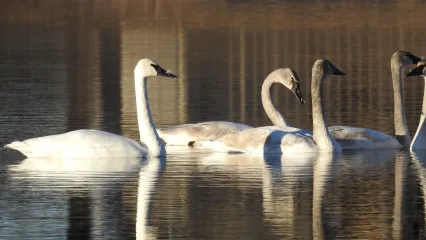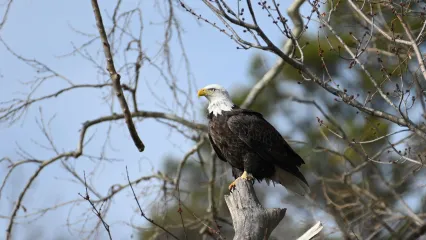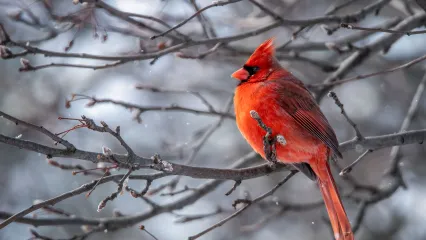
Description
Trumpeter swans historically nested on freshwater lakes and marshes in a wide band across the northern United States, Canada and Alaska, and may have occurred in numbers as high as 100,000 birds. However, nearly all of the population east of the Rocky Mountains was extirpated in the late 1800s as a result of unregulated market hunting and habitat loss. Beginning in the early 1960s, state wildlife agencies and the U.S. Fish and Wildlife Service mounted a series of restoration efforts to rerum the trumpeter swan to the Midwest through the release of birds into Minnesota, Wisconsin, Iowa, Michigan and Ohio. During the past 40 years, this Midwestern population has grown from a few hundred released birds to a thriving and reproducing population of over 4,500 birds in six states and the province of Ontario.
Many of the nesting swans in Iowa, Wisconsin and Minnesota are marked with colored neck bands - long collars that are placed around the lower portion of the swan's neck. These bands or collars are red or green in color and Oklahoma lies substantially south of the trumpeter swan's historic nesting range, hut at one time our state was the wintering home for many hundreds, if not thousands of trumpeter swans. are printed with a unique combination of letters and numbers. Using the collars, biologists can track specific birds and identify their traditional nesting and wintering areas. In recent years, many of the trumpeter swans sighted in Oklahoma have originated from birds released onto wetlands in central Iowa. The Oklahoma Wildlife Diversity Program assists the Trumpeter Swan Society which is a non-profit organization based in Minnesota that helps to track and monitor the Midwestern swan population. All winter-time swan sightings are noteworthy, but we are especially interested in any observations of collared swans. Recording the locations of collared swans can help us document migration routes between their northern nesting areas and the suitable wintering areas that occur in Oklahoma. If you observe a swan with a neck collar, please contact the Wildlife Diversity Program or the Trumpeter Swan Society through their Trumpeter Watch program.
Size
Trumpeter swans can grow at a height of 5ft 5in.
Habitat
Oklahoma lies substantially south of the trumpeter swan's historic nesting range, but at one time our state was the wintering home for many hundreds, if not thousands of trumpeter swans. History is now repeating itself with growing numbers of trumpeter swans once again wintering in Oklahoma as the Midwestern population recovers. Many of the trumpeter swans that visit Oklahoma originate from the re-established nesting populations in Iowa, Minnesota and Wisconsin. In Oklahoma, these birds occupy large ponds and wetlands and are found primarily in the northeastern and northcentral portions of the state. A few additional wintering swans migrate down from a High Plains population that was recently established in South Dakota, Nebraska and Wyoming.
These swans winter primarily on ponds and flood control lakes in western Oklahoma. Trumpeter swans typically occur in Oklahoma during the mid-winter - roughly between late November and late February.
Life Cycle
The trumpeter swan is the largest species of waterfowl in North American and the larger of the two native swan species. These birds often live 20 to 25 years and pairs may remain together for ten or more nesting seasons. Each summer, the pair jointly raises a brood of one to six young known as cygnets. The young swans typically remain with their parent during their first summer and winter in order to learn how to find food and avoid predators and other hazards. Because of their strong family bonds, most trumpeter swan sightings in Oklahoma are of family groups. These groups are commonly comprised of one or two adult pairs and two to eight juvenile birds. Adult trumpeter swans have completely white plumage, and a relatively long, sloping bill that is solid black and somewhat wedge-shaped. Young trumpeter swans have plumage that is sooty gray in color, and have a patch of pinkish-orange color on their predominantly black bills.

